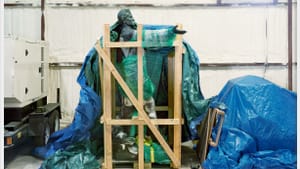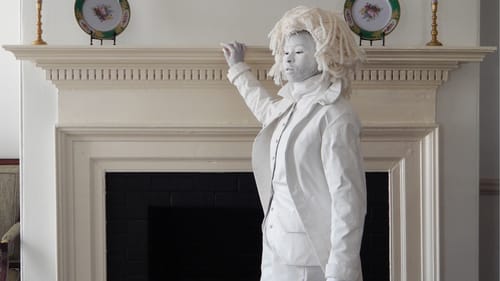Stay in the Loop
BSR publishes on a weekly schedule, with an email newsletter every Wednesday and Thursday morning. There’s no paywall, and subscribing is always free.
A monumental re-think
The Print Center presents ‘(Un)Making Monuments’

What to do with memorials that have become social-justice flashpoints? (Un)Making Monuments, a new completely virtual exhibition from the Print Center, stakes out thoughtful territory between veneration and desecration, and through the lenses of a dozen artists, proposes new ways of seeing statues, shrines, memorials, and markers.
Print Center galleries remain closed to in-person visits due to the Coronavirus pandemic. According to curator Ksenia Nouril, the digital format had advantages, enabling her to expand the artists and periods under consideration. Which underscores her observation that “debates over the fate of monuments are perennial.” Nouril, an art historian, previously studied post-communist monuments across Eastern Europe.
Postcards on the edge
There are no postcard views in the exhibition, though works by Michael Mergen and Nona Faustine mimic them. In the wake of Dylann Roof’s 2015 massacre of a Bible-study class in South Carolina, Mergen created Confederate Heroes, Confederate Dead (2015). Crossing Virginia, he photographed 68 statues honoring Civil War soldiers, some of which had been erected as recently as 2007.
Five Faustine images from the 2019 series My Country look like chamber of commerce images that met with unfortunate darkroom accidents. Bleached out, blacked out, bisected by slashes of red dye, they depict the turbulent reality beneath commemorative mythology.
In five images from Volte-Face (2016), Oliver Curtis inverts stereotypical perspectives: marching up to presumed subjects, he did an about-face to reveal the view from, rather than of, landmarks like the Statue of Liberty and the Hollywood sign.
The element of time
The exhibit opened in four phases during October, restoring a sense of anticipation to an arts world accustomed to bingeing and zooming. With full content now available, the site, designed by The Print Center’s Mikaela Hawk, still provides viewers the option of exploring one theme or artist at a time.
The passage of time is implied in three images by Lee Friedlander. With the nation’s bicentennial approaching, he traveled cross-country with his 35mm camera to capture The American Moment (1976) in 213 pictures. A century after the battle of Gettysburg, Friedlander shows how a copse of trees have obscured battlefield memorials. In New York City, a World War I statue is overwhelmed by the visual cacophony of Times Square. At Mount Rushmore, 20th-century tourists peer through binoculars at distant founders, carved into a mountain.
Wrapping up the past
An-My Lê, whose family fled the Vietnam War, documents the lingering effects of America’s Civil War in the series The Silent General (2016, 2017, 2020). In a Homeland Security storage facility, she photographed memorials in limbo. Robert E. Lee and P.G.T. Beauregard stand in a shed so new you can practically smell the plywood, and appear to be in conversation. This year, Lê returned to shoot Jefferson Davis, banished to a cage of two-by-fours, swathed in green and blue protective wrap.
Seeing figures lowered unharmed from their pedestals and simply removed may dilute monuments’ emotional power with more finality than seeing them spattered with paint, set aflame, and hacked apart. Consider what those who cherish symbols of the antebellum south would think if they saw their heroes, instead of being martyred, treated as excess lawn equipment. Destruction may be more viscerally satisfying, but relocation is more effective.
Matthew Shain’s Post-Monuments (2017, 2018) are a perfect companion to Lê’s quarantined commanders. Photographing evacuated plinths, pedestals, and niches, he reveals what’s left after the show closes: vacant stages, altars for quiet contemplation.

Seeing Columbus and Jefferson
Joiri Minaya solicits viewer input on her “artistic interventions,” proposals for two of which are included in the exhibit. Both reimagine Christopher Columbus statues (Nassau, Bahamas, 2017, and New York City, 2020), wrapping the explorer in colorful fabric symbolizing the cultures injured by his voyages.
The photo collages consist of computer-generated makeover images and handwritten opinions. Among the comments were these, responding to Minaya’s plan to reupholster the statue in New York’s Columbus Circle in a design of plants used by enslaved Africans and Indigenous peoples of the Americas: “By choosing him as a figure to distort, are you adding to the significance of this controversial figure?” and “…now that I’ve imagined CC in a vivid, rich color palette with a deepened history, I don’t want to see the statue as anything but.”
Marisa Williamson literally takes on the enslaving author of the Declaration of Independence in The Ghost of Thomas Jefferson (2018). Chalk-white from head to toe, Williamson as Jefferson revisited the University of Virginia, where white nationalists gathered in 2017. Photographed by Gabby Fuller, she wandered among campus landmarks to create a postcard memory book. The performance artist’s deadpan expression is belied captions such as: “How did Thomas Jefferson find himself atop so many pedestals,” and “The Ghost of Thomas Jefferson appears at home in fine white spaces.”
Barometers of us
In the 2019 series Federal Triangle, Mike Osborne’s prey is federal government buildings. The mostly nighttime shots depict exterior views Washington, DC tourists don’t seek out. At the Weaver Federal Building, a bureaucratic honeycomb, all the windows are dark save one. Who’s up there, and what are they doing? At the Supreme Court, a lone federal worker hauls a hose up the marble steps to wash away the residue of judgment. A sidewalk view of the Eisenhower Memorial is totally obliterated by fashionable barriers like those currently ringing the White House.
Unlike destruction, deconstruction of public monuments allows us to autopsy motives in the past and present. It provides context, leading to greater awareness. Our memorials are barometers of who we were, who we are, and who we’re trying to become.
Image description: A photo by An-My Lê of a larger-than-life statue of Jefferson Davis, sitting in a white-walled warehouse. It’s in a partial box of wooden planks, partially swathed in green bubble wrap and green and blue tarps.
Image description: A photo by Gabby Fuller of artist Marissa Williamson, who is wearing a stiff-looking ensemble of an 18th-century man, including knee-high boots, a vest, and long, high-collared jacket. The clothes are all pure white, and Williamson’s skin is covered in white makeup, and she wears a white wig. She poses in profile next to a large 18th-century fireplace.
What, When, Where
(Un)Making Monuments. Free to view online through December 30, 2020 via The Print Center, 1614 Latimer Street, Philadelphia. (215) 735-6090 or printcenter.org.
The Print Center building is closed to visitors due to COVID-19. The Gallery Store is open by appointment.
Sign up for our newsletter
All of the week's new articles, all in one place. Sign up for the free weekly BSR newsletters, and don't miss a conversation.
